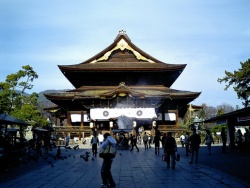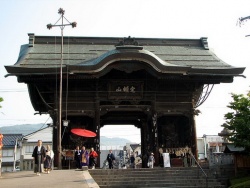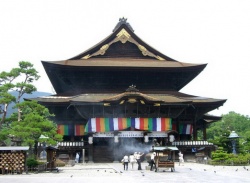Zenko-ji
Zenko-ji
[善光寺] Zenko-ji
A temple in Nagano Prefecture, Japan, affiliated with the Tendai and the Pure Land (Jodo) schools. Built in the seventh century, it enshrines a statue of Amida Buddha flanked by those of the bodhisattvas Perceiver of the World's Sounds and Great Power. According to this temple's tradition, the statue was Japan's first Buddhist image, sent by King SyØngmyØng of the Korean kingdom of Paekche to the Japanese emperor Kimmei in 552 (the traditionally accepted date for the formal introduction of Buddhism to Japan). The Mononobe clan, who opposed Buddhism and claimed it to be the cause of epidemics, repeatedly discarded the statue. According to tradition, however, it was retrieved each time by the Soga clan, the pro-Buddhist faction. In 602 the statue Zen school 832 was transported to Shinano Province (present-day Nagano Prefecture) and enshrined in 642 at Zenko-ji temple, which was built that year.
Zenkō-ji (善光寺?) is a Buddhist temple located in Nagano, Japan. The temple was built in the 7th century. Nagano City, established in 1897, was originally a town built around the temple. Historically, Zenkō-ji is perhaps most famous for its involvement in the battles between Uesugi Kenshin and Takeda Shingen in the 16th century, when it served as one of Kenshin's bases of operations. Currently, Zenkō-ji is one of the last few remaining pilgrimage sites in Japan.
Zenkō-ji was founded before Buddhism in Japan was split into several different sects, so it currently belongs to both the Tendai and Jōdoshū schools of Buddhism, and is co-managed by twenty-five priests from the former school, and fourteen from the latter. The temple enshrines images of the Amida Buddha. According to legend, the image, having caused dispute between two clans, was dumped into a canal. It was later rescued by Yoshimitsu Honda. The temple was thus named "Zenkō," according to the Chinese transliteration of Yoshimitsu's name.
The main Buddhist image is a hibutsu (secret Buddha), a hidden Buddha statue, not shown to the public. This hibutsu is rumored to be the first Buddha statue to ever be brought to Japan. The commandments of the temple require the absolute secrecy of the statue, prohibiting it to be shown to anyone, including the chief priest of the temple. However, a replica of the statue (Maedachi Honzon) has been created which can be shown publicly once every six years in spring, in a ceremony called Gokaichō. This event attracts many worshipers and visitors. When the statue was on display in 2003, Zenkō-ji cooperated with Motozenkō-ji and Zenkō-ji of Kofu, Yamanashi Prefecture. The most recent display of "Maedachi Honzon" took place in April and May, 2009.
The temple contains a statue of Binzuru, a physician who was said to be Buddha's follower. Visitors to the temple touch the statue in order to cure their ailments. The temple also contains an inner prayer chamber, accessible to visitors. Currently, a daily morning ritual is held there by the high priest or priestess. From the inner chamber, a narrow staircase leads down to a completely dark corridor. In this corridor worshippers try to touch a metal key hanging on the wall, in order to gain enlightenment. The key represents the Key to the Western Paradise of the Amida Buddha.
History
According to the explanation of Zenkō-ji, The Hibutsu, or the Main Image of Zenkō-ji, moved from India to Japan by way of the Korean peninsula, in the 6th century, during the reign of Emperor Kimmei.[1] Afterwards, it was moved several times before coming to rest at its present location in Nagano city.
At the end of the Kamakura period (1185–1333), many temples copied Zenkō-ji's famous Buddha statue, and many new temples were built around the country, calling themselves "Zenkō-ji" or "Shin-Zenkō-ji" (The New Zenkō-ji).
In the Sengoku period (mid-15th to 17th century), when the Zenkō-ji became embroiled in the struggles between Uesugi Kenshin and Takeda Shingen, the chief abbot was afraid it would be burnt to the ground. He built a new Zenkō-ji in what is now Kofu; it stands to this day.
In 1598, Toyotomi Hideyoshi moved the hibutsu to Kyoto, and then to Shinano. The hibutsu and the Zenkoji temple itself have since been moved back to Nagano.
Zenkō-ji temple decided to pull out of the 2008 Summer Olympics torch relay, in relation with the 2008 Tibetan unrest and in solidarity with the Tibetan buddhists.[2] The Zenkō-ji temple was then vandalized.[3]
Inside the compound
The Zenkō-ji compound contains many interesting and historically significant buildings. The compound is arranged in a linear fashion, from the south to the north, so that worshipers and visitors would likely see the buildings in this order. Admission to most of the buildings at the compound is covered by a ticket which costs ¥500. The ticket can be re-used at different buildings.
Daihongan
Immediately on the left, from the southern entrance, this Jōdo Sect temple houses the nunnery and the residence of the high priestess.
Niōmon


